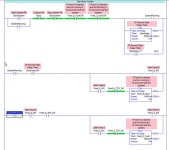Aggregateman
Member
Hi everyone, first time posting here, so I'll just get right to the meat of my situation here.
I've just started getting into PLCs and I work in a gravel mine, we have a total of 7 conveyors that carry raw material to the processing plant, over about 5,000 feet, and I need to create a program to start all of the conveyors in sequence from 7 to 1 as well as be interlocked together so if the tail pulley sensor from any conveyor stops reporting the whole line shuts down. the system we are going with using is a 1769 compactlogix with networked I/O along near each motor starter set. each conveyor will have a tail pulley sensor that the next conveyor uses to verify that it is turning.
My problem is that I took a class at the local college and I learned a little bit on rslogix500, but he spent most of his time teaching us about antiquated hardware and binary number systems. Now I have studio 5,000 and am trying to adjust to its differences from 500, and don't even know a lot about motor starter control on PLCS. if anyone could help me out with some ideas or pointers as to the best way to sequence start these and interlock them, I would be most appreciative. I can provide more info if I missed anything important, but I think I covered everything.
Thanks in advance!
I've just started getting into PLCs and I work in a gravel mine, we have a total of 7 conveyors that carry raw material to the processing plant, over about 5,000 feet, and I need to create a program to start all of the conveyors in sequence from 7 to 1 as well as be interlocked together so if the tail pulley sensor from any conveyor stops reporting the whole line shuts down. the system we are going with using is a 1769 compactlogix with networked I/O along near each motor starter set. each conveyor will have a tail pulley sensor that the next conveyor uses to verify that it is turning.
My problem is that I took a class at the local college and I learned a little bit on rslogix500, but he spent most of his time teaching us about antiquated hardware and binary number systems. Now I have studio 5,000 and am trying to adjust to its differences from 500, and don't even know a lot about motor starter control on PLCS. if anyone could help me out with some ideas or pointers as to the best way to sequence start these and interlock them, I would be most appreciative. I can provide more info if I missed anything important, but I think I covered everything.
Thanks in advance!






